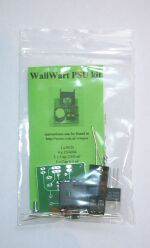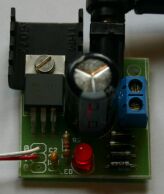
WWPSU : Wall Wart PSU Kit


|
WWPSU : Wall Wart PSU Kit |

|
The circuit is very simple: the AC or DC from the Wall Wart connected to the board by the power plug or the screw connector. It is rectified by the four diodes D1 .. D4 and fed into the buffer elco C1. The 7805 voltage regulator converts the rippling voltage on the buffer elco into a clean 5 Volt. A LED with a resistor provide visual indication that power is present (and that the output is not accidentally shorted). The small capacitor C2 at the output of the 7805 stabilizes the regulator.
I assume you know how to solder a PCB. Be patient, don't use too much solder and check your work under a strong lamp (a magnifying glass might be handy).
You can click on each of the pictures to get a larger picture.
This circuit will work with any Wall Wart that provides either 7 .. 24 Volt AC or 8 .. 32 Volt DC. The 7805 is both short-circuit and thermally protected, so it is difficult to damage. If you want to draw substantial current you should use a Wall Wart with low voltage (7 V AC or 8 V DC), and/or put a larger heat sink on the 7805 than the one provided in the kit. With the provided heat sink the 7805 can dissipate at least 3 Watt.
The input is provided by the screw terminal or the power connctor, your choice. The power connector might be most convenient, but for a sturdy connection the screw terminal will be better. The input is rectified, so for a DC Wall Wart it does not matter how the + and - leads are connected. The 5 Volt output is provided on the three unused holes at the left of the PCB. The two outer holes are at ground (0 Volt), the inner is at + 5 Volt.
http://www.voti.nl/wwpsu
Copyright (c) 2002, 2006 Van Ooijen Technische Informatica / Wouter van Ooijen